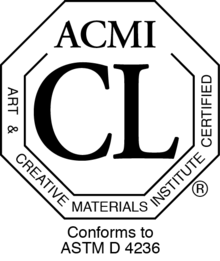Art & Creative Materials Institute
About ACMI
The Art and Creative Materials Institute, Inc. (ACMI) is a non-profit, international association of about 200 art, craft and creative material manufacturers which seeks to promote safety in art and creative products through its certification program. Many small companies, as well as large ones, participate in the ACMI product certification program. Nearly a quarter of these companies are long-standing members (20+ years) of ACMI.
Since 1936, the ACMI program for children’s art materials has certified that products are non-toxic using the AP Seal. In 1982, the program was expanded to include a much broader range of art materials, including adult products, ensuring that they are non-toxic (AP Seal) or carry appropriate health warning labels (CL Seal) where necessary.
ACMI-certified product seals (AP Approved Product and CL Cautionary Labeling - see "The ACMI Certification Seals" below) indicate that these products have been evaluated by a qualified toxicologist and are labeled in accordance with federal and state laws. Each product in the program undergoes extensive toxicological testing that covers both acute and chronic toxicity concerns before it is granted the right to bear the ACMI certification seal. The ACMI product certification program includes an ongoing review of the latest scientific and regulatory information available to keep the program current. The program also includes a five-year review of product formulations to meet the requirements of the Labeling of Hazardous Art Materials Act.[1]
ACMI was initially known as the Crayon, Water Color & Craft Institute, Inc. It was renamed the Art & Craft Materials Institute in 1982. It adopted its current name in the late 2000s.

ACMI was founded in 1936 and is currently headquartered in Hingham, Massachusetts.
The ACMI Certification Seals
The AP (Approved Product) Seal
The AP (Approved Product Seal) identifies art materials that are safe and that are certified in a toxicological evaluation by a medical expert to contain no materials in sufficient quantities to be toxic or injurious to humans, including children, or to cause acute or chronic health problems. Such products are certified by ACMI to be labeled in accordance with the chronic hazard labeling standard, ASTM D 4236, and the U. S. Labeling of Hazardous Art Materials Act (LHAMA).

The CL (Cautionary Labeling)
The CL (Cautionary Labeling) Seal identifies products that are certified to be properly labeled in a program of toxicological evaluation by a medical expert for any known health risks and with information on the safe and proper use of these materials. This Seal appears on only a small percentage of adult art materials in ACMI’s certification program and on none of the children’s materials. These products are also certified by ACMI to be labeled in accordance with the chronic hazard labeling standard, ASTM D 4236, and the U. S. Labeling of Hazardous Art Materials Act (LHAMA). Products with this seal are not hazardous if used correctly. It is important to read the product label in full before opening a product that has the CL Seal.
These products should never be given to children in grade 6 or lower or anyone with a physical or mental handicap who is unable to read and understand safety labeling on packages.[2]
The Council for Art Education
ACMI was the founding member of the Council for Art Education, Inc. (CFAE), which promotes art education across the US. CFAE holds March as Youth Art Month and encourages teachers to involve students in their art month flag program. They continue to be CFAE's largest supporter today.[3]
Relationship with Duke University
ACMI’s toxicology team, located at Duke University’s Division of Occupational and Environmental Medicine, has over 30 years experience evaluating more than 60,000 art material formulations for ACMI members. ACMI also has a Toxicological Advisory Board composed of leading toxicological experts who act as a review board on issues of toxicity, review the criteria used by ACMI’s Toxicologist and make recommendations to ACMI.[4]